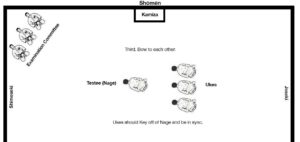Randori versus Jiyu Waza.
Jiyu Waza
Let me first define what Jiyu Waza is in Aikido. Predetermined attack (specific grab, strike, etc.) and any technique nage (defender) chooses. Not predetermined for example, like Shomenuchi Ikkyo Omote.
So big picture, this is an advanced practice. You need to have a few years under belt of understanding opening tae sabaki. You need to have control. You need to be safe. And finally, this is where you start to have a variety of techniques (2, 3, 4, 5, 10+, etc.)
So in our organization, the USAF, at the Nikyu (2nd Kyu) Test, Jiyu waza comes in with 2 attackers at once. Ikkyu (1st Kyu) Test, 3 attackers, Shodan (1st Degree Black Belt) 4+ and on and on.
Strategy
This is the blueprint we incorporate in our dojo when you get to the level of practicing jiyu waza, specifically for the 2nd Kyu test. Usually around Sankyu (3rd Kyu), you start to develop an order of techniques. And you want to practice that order over and over so it becomes 2nd nature.
Tip
At this stage, you just want 5 different kihon techniques (nothing too elaborate or fancy) for example, Iriminage, Kotegaeshi, Shihonage, Udekeminage, Kaitennage. It’s also important to move and flow and have a defined opening for each technique.
As you develop and increase your repetoire, increase rank, years, you can then develop 7-10 different techniques from each attack. In conclusion, what separates a ‘Good Test’ from an ‘Excellent Test’ or practice is whether you repeat techniques inside that series.
Randori
Randori is simply freestyle in Aikido. Not specified attack (specific grab, strike, etc.) with any technique nage (defender) chooses.
This is where you bow in, nage in front (about 10-15 feet) with 2, 3, 4, 5+ ukes (attackers) and the pace is faster, more intense and realistic.
In the beginning of Randori learning, we want you to be deliberate in your opening, tenshin (stepping back and blending) along with Irimi-tenkan are going to serve you the best. As you advance, Irimi and Sudori come in too. You will usually start with Ryo-katatori (pushing chest) and work into your movement.
As you advance, the attacks will vary from strikes to grabs to ushiro, etc. At this point, you need to be very efficient in your movement and make sure you complete each opening, technique and ending with zanshin.
Strategy
Finally, as you move into the higher Dan ranks, where you move becomes more important, atemi-waza and constant movement will make it difficult for your attackers (uke) to lock down on you which can make challenging to get away safely.
Here is a Randori from Jim Hyde’s Shodan test (2011).
For more Blog posts like “Randori versus Jiyu Waza” check back regularly.
5 Questions with our Chief Instructor – Part 2
5 Questions with our Chief Instructor – Part 2 Jared Heintz: Aikido is often praised for its applicability in self-defense situations. Could you discuss how Aikido techniques can be adapted to real-world scenarios, and what mindset one should cultivate in such situations? Weiner Sensei: As I approach 25 years of Aikido practice, I’ve realized that…
Rank Testing Bowing Reiho – Advanced
Rank Testing Bowing Reiho – Advanced Andy Demko Shihan likes to say, “The little things don’t mean a lot, they mean everything”. Everyone who has practiced in our dojo or visited has seen that we take Reiho (Etiquette) pretty seriously. In all that we do, practice. Bowing. Addressing each other & more. I learned a…
Sensei
Sensei 先生 The two characters that make up the term can be directly translated as “born before,” and imply one who teaches based on wisdom gained from age and experience. In general usage, it is used, with proper form, after a person’s name and means “teacher.” In Japan, the word is also used as a…



